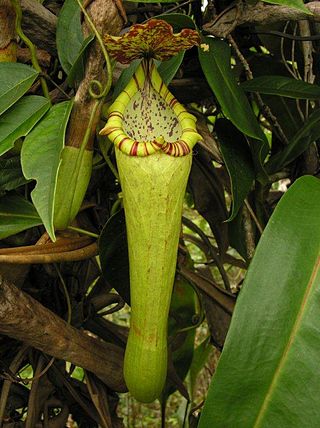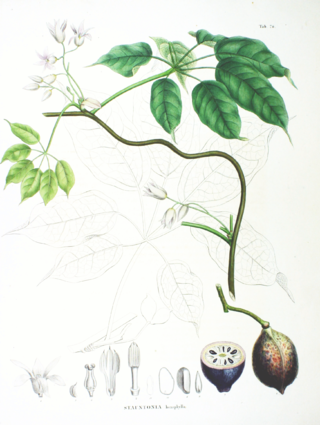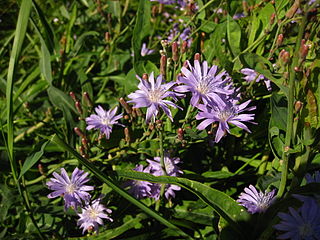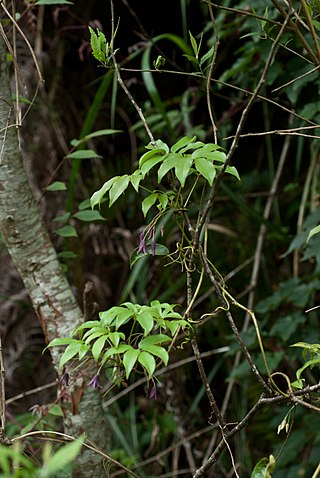
Trillium is a genus of about fifty flowering plant species in the family Melanthiaceae. Trillium species are native to temperate regions of North America and Asia, with the greatest diversity of species found in the southern Appalachian Mountains in the southeastern United States.

Lilium is a genus of herbaceous flowering plants growing from bulbs, all with large and often prominent flowers. They are the true lilies. Lilies are a group of flowering plants which are important in culture and literature in much of the world. Most species are native to the Northern Hemisphere and their range is temperate climates and extends into the subtropics. Many other plants have "lily" in their common names, but do not belong to the same genus and are therefore not true lilies. True lilies are known to be highly toxic to cats.

Clematis is a genus of about 380 species within the buttercup family, Ranunculaceae. Their garden hybrids and cultivars have been popular among gardeners, beginning with Clematis 'Jackmanii', a garden staple since 1862; more cultivars are being produced constantly. They are mainly of Chinese and Japanese origin.

Saxifraga is the largest genus in the family Saxifragaceae, containing about 473 species of holarctic perennial plants, known as saxifrages or rockfoils. The Latin word saxifraga means literally "stone-breaker", from Latin saxum + frangere. It is usually thought to indicate a medicinal use for treatment of urinary calculi, rather than breaking rocks apart.

Nepenthes boschiana, or Bosch's pitcher-plant, is a tropical pitcher plant endemic to Borneo. It is most closely allied to N. faizaliana. Nepenthes borneensis is considered a synonym of this species. Nepenthes boschiana has no known natural hybrids. No valid forms or varieties have been described. Nepenthes boschiana belongs to the loosely defined "N. maxima complex", which also includes, among other species, N. chaniana, N. epiphytica, N. eymae, N. faizaliana, N. fusca, N. klossii, N. maxima, N. platychila, N. stenophylla, and N. vogelii.

Stauntonia is a genus of flowering plants in the family Lardizabalaceae. It is named after George Staunton, who brought it to Britain from China in the 19th century.

Ilex or holly is a genus of over 570 species of flowering plants in the family Aquifoliaceae, and the only living genus in that family. Ilex has the most species of any woody dioecious angiosperm genus. The species are evergreen or deciduous trees, shrubs, and climbers from tropics to temperate zones worldwide. The type species is Ilex aquifolium, the common European holly used in Christmas decorations and cards.

Lactuca tatarica, known as blue lettuce, is a Eurasian flowering plant in the tribe Cichorieae within the family Asteraceae. It is widespread across much of Europe and Asia.

Fritillaria japonica is a perennial herbaceous bulbous plant, endemic to Japan. It is a species in the genus Fritillaria, in the family Liliaceae. It is placed in the subgenus Japonica.

Stauntonia purpurea is a plant in the family Lardizabalaceae.

Stauntonia chinensis is a plant in the family Lardizabalaceae. It is endemic to China, where it is distributed in Yunnan, Guangxi, Guangdong, Zhejiang, Jiangxi, Fujian, Hunan, Anhui, Hong Kong, Guizhou and other places. It grows at an altitude of 500 meters to 1,300 meters above sea level and can be found in dense forests in mountainous areas, thickets on the hillside or sparse forests along the streams in valleys.
Stauntonia trinervia is a plant in the family Lardizabalaceae. It is distributed in Guangdong and other parts of mainland China, and grows at an altitude of 350 to 500 meters above sea level in open forests beside water in valleys.
Stauntonia obovata is a plant in the family Lardizabalaceae. It is distributed in Taiwan and mainland China in Guangdong, Sichuan, Fujian, Guangxi, Jiangxi, Hong Kong, Hunan and other places. It grows in areas with an altitude of 300 to 800 meters, mostly in open forests or dense forests in mountain valleys.
Stauntonia brunoniana is a plant in the family Lardizabalaceae. It is distributed in Vietnam, India, Myanmar, and Yunnan in mainland China, and grows at an altitude of 900 to 1,500 meters above sea level, generally in mountain forests.
Stauntonia brachyandra is a plant in the family Lardizabalaceae.
Stauntonia yaoshanensis is a species of flowering plant in the family Lardizabalaceae. Its native range is Guangxi and other provinces of southeast China. It is a climber and grows primarily in the subtropical biome.
Stauntonia grandiflora is a plant in the family Lardizabalaceae. The native range of this species is South-Central China to Vietnam. It is a climber and grows primarily in the temperate biome.
Stauntonia conspicua is a plant in the family Lardizabalaceae. It is endemic to China, distributed in Zhejiang Province in mainland China. It grows at an altitude of 1,300 to 1,600 meters above sea level, often in dense forests on mountain slopes.
Stauntonia crassifolia is a plant in the family Lardizabalaceae. The native range of this species is Myanmar. It is a subshrub and grows primarily in the subtropical biome.
Stauntonia maculata is a plant in the family Lardizabalaceae. The native range of this species is China. It is a climber and grows primarily in the subtropical biome, at an altitude of 600 to 1,000 meters above sea level. It is mostly found in open forests in mountainous areas or in sunny places beside streams in valleys.











